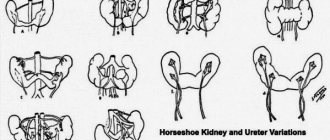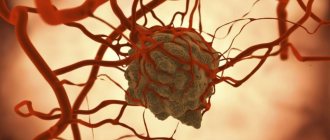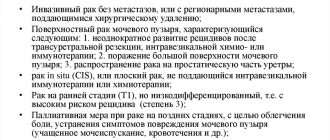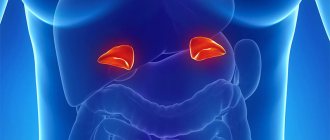If you are diagnosed with localized renal cell cancer, your doctor may recommend treatment with partial nephrectomy, radical nephrectomy, active surveillance, radiofrequency ablation, or cryotherapy. Each method has its own advantages and disadvantages. The choice of treatment depends on your individual situation.
Localized renal cell kidney cancer refers to a tumor that is limited to the kidney and has not spread to other parts of the body. This may be a stage I or II tumor, depending on its size (Figures 1 and 2).
Rice. 1 Kidney tumor stage I - tumor up to 7 cm, limited to the kidney.
Rice. 2 Stage II tumor still limited to the kidney, but larger than 7 cm.
Treatment Options
The best option for treating a kidney tumor is surgical removal.
Localized renal cell cancer of the kidney can be removed by partial nephrectomy (partial nephrectomy) or radical nephrectomy. Both operations can be performed open or laparoscopically. Laparoscopic surgery can also be performed using a surgical robotic system.
During a partial nephrectomy, only the tumor is removed, leaving healthy kidney tissue intact. This operation is recommended whenever possible. If it is impossible to remove the entire tumor leaving the kidney intact, radical nephrectomy is recommended. This means that the kidney where the tumor is located and the surrounding tissue will be completely removed.
Sometimes surgery may not be the best treatment option. This may be due to your age or health condition. If the tumor is smaller than 4 cm, your doctor may suggest a period of active surveillance. During active surveillance, a schedule of regular visits is made to monitor the tumor. If the tumor continues to grow, further treatment may be needed. Ablative therapy may be a good option in this case.
Ablative therapy can be either radiofrequency ablation or cryotherapy. The goal of these procedures is to kill tumor cells by heating or freezing them (cryotherapy). Here are some topics to discuss with your doctor when planning your treatment:
- History of your illness
- Have you had or have a history of kidney cancer in your family?
- What to consider if you only have one kidney
- How do the kidneys function if they have already been affected by other factors: diabetes or high blood pressure?
- You have a tumor in one or both kidneys
- Type of treatment available at your hospital
- Your doctor's experience.
- Your personal preferences and values.
- Support during and after treatment.
Partial nephrectomy (kidney resection)
Partial nephrectomy is a surgical option for the treatment of localized renal cell carcinoma of the kidney. Recommended whenever possible. The goal is to remove the part of the kidney that has been affected by the tumor and leave as much healthy kidney tissue as possible.
General anesthesia is used to perform a partial nephrectomy. During surgery, you will lie on your side or back, depending on the location and size of the tumor.
How is a partial nephrectomy performed?
First, the exact location of the tumor is determined. A clamp is placed on the renal artery to stop the blood supply to the kidney during surgery to reduce blood loss. This allows the entire tumor to be removed. Crushed ice is sometimes used during surgery to lower the temperature of the kidney and prevent damage from lack of blood flow.
After removing the tumor, the surgeon sutures the area where it was located (Fig. 3).
Rice. 3 In a partial nephrectomy, the tumor is removed, leaving as much healthy kidney tissue as possible.
If the tumor has spread into the renal cavity, a stent may need to be placed in the ureter to ensure adequate flow of urine away from the kidney. The stent will be removed after the wounds have healed and urine flow has normalized. This may take from several days to several weeks (Fig. 4).
Rice. 4 A ureteral stent was installed for adequate urine outflow
Partial nephrectomy can be performed either open or laparoscopically.
Open surgery is the standard method. The surgeon makes an incision into the abdominal wall to directly access the kidneys and tumor.
Laparoscopic partial nephrectomy is a minimally invasive procedure. During such operations, ports (tubes) are inserted through the abdominal wall, through which special instruments necessary to remove the tumor are passed. One of the ports is used to insert a camera, which allows the surgeon to see a high-quality image on a monitor (Fig. 5).
Rice. 5 In laparoscopic surgery, instruments are inserted through small ports in the abdomen.
Laparoscopic surgery can also be performed using a surgical robotic system. Laparoscopic surgery usually results in faster recovery compared to open surgery.
For renal tumor removal with partial nephrectomy, open and laparoscopic operations are equally effective.
How to prepare for surgery?
The doctor will explain exactly how you need to prepare for this operation in your situation. You cannot eat, drink, or smoke 6-8 hours before surgery. If you are taking any medications, tell your doctor. It may be necessary to stop certain medications several days before surgery.
What are the side effects of the surgery?
You can usually leave the hospital 3-7 days after surgery. Keep in mind that the length of hospital stay may vary in different situations. After an open partial nephrectomy, you may have pain in the side where the procedure was performed for several weeks. Recommendations for 4-6 weeks after surgery:
- Drink 1-2 liters every day, especially water.
- Do not lift anything heavier than 5 kilograms.
- Do not engage in heavy physical labor.
- Discuss any medicine you take with your doctor.
- If necessary, discuss with your doctor when to remove the ureteral stent.
You need to see a doctor immediately or return to the hospital if:
- Developed a fever
- There is some blood in the urine
- You are bleeding heavily or in pain
What are the results of treatment?
Partial nephrectomy is the treatment of choice for localized renal cell carcinoma of the kidney. More than 95% of patients are relapse-free up to 5 years after this surgery. The benefit of having two functioning kidneys after surgery contributes to the normal functioning of the body as a whole.
What will be the next steps?
After a partial nephrectomy for kidney cancer, regular visits to your doctor are scheduled to monitor your condition. The frequency of such visits depends on the classification of the tumor removed (see: Diagnosis and classification). The duration of observation is at least 5 years. Common tests during follow-up visits include CT scan of the abdomen and retroperitoneum, ultrasound examination, chest x-ray, urine and blood tests.
Radical nephrectomy
Radical nephrectomy is a surgical option for the treatment of localized renal cell carcinoma of the kidney. The goal is to remove the entire kidney and surrounding fatty tissue. This operation is performed when it is impossible to remove the tumor and leave part of the kidney intact. Typically recommended for stage II kidney cancer or stage I tumors when partial nephrectomy is not an option. Most people can live with just one functioning kidney without serious complications.
Radical nephrectomy is performed under general anesthesia. During surgery, you will lie on your side or back, depending on the location and size of the tumor.
How is radical nephrectomy performed?
First, the size of the tumor is determined. To prevent tumor dissection, the surgeon removes your kidney along with the perinephric fatty tissue. The surgeon then separates the renal artery, renal vein, and ureter from the kidney (Figure 6). Finally, the kidney is removed.
Rice. 6 The tumor is removed along with the entire kidney
Radical nephrectomy can be performed laparoscopically. During such operations, ports (tubes) are inserted through the abdominal wall, through which special instruments necessary to remove the tumor are passed. One of the ports is used to insert a camera, which allows the surgeon to see a high-quality image on a monitor (Fig. 5).
Rice. 5 In laparoscopic surgery, instruments are inserted through small ports in the abdomen.
Laparoscopic surgery usually results in faster recovery compared to open surgery. Laparoscopic surgery can also be performed using a surgical robotic system.
Open radical nephrectomy may be recommended in certain cases or if laparoscopic surgery is not available at your hospital. In an open radical nephrectomy, the surgeon makes a cut in the abdominal wall to directly access the kidneys. The surgery has a longer recovery time and a higher risk of complications compared to laparoscopy.
Radical nephrectomy for kidney tumors is equally effective when performed open or laparoscopically.
How to prepare for surgery?
The doctor will explain exactly how you need to prepare for this operation in your situation. You cannot eat, drink, or smoke 6-8 hours before surgery. If you are taking any medications, tell your doctor. It may be necessary to stop certain medications several days before surgery.
What are the side effects of the surgery?
You can usually leave the hospital 3-7 days after surgery. Keep in mind that the length of hospital stay may vary in different situations. After an open radical nephrectomy, you may have pain in the side where the procedure was performed for several weeks. Recommendations for 4-6 weeks after surgery:
- Drink 1-2 liters every day, especially water.
- Do not lift anything heavier than 5 kilograms.
- Do not engage in heavy physical labor.
- Discuss any medicine you take with your doctor.
You need to see a doctor immediately or return to the hospital if:
- Developed a fever
- There is some blood in the urine
What are the results of treatment?
Radical nephrectomy is a commonly used procedure for localized renal cell carcinoma. About 90% of patients still have cancer up to 5 years after surgery. Because you are left with one functioning kidney, there is an increased risk of chronic kidney disease. Decreased kidney function is also a risk factor for cardiovascular disease.
What will be the next steps?
After radical nephrectomy for kidney cancer, regular visits to your doctor are scheduled to monitor your condition. The frequency of such visits depends on the classification of the tumor removed (see: Diagnosis and classification). The duration of observation is at least 5 years. Common tests during follow-up visits include CT scan of the abdomen and retroperitoneum, ultrasound examination, chest x-ray, urine and blood tests.
Active Surveillance
Active surveillance is a form of treatment for localized renal cell cancer in which the doctor actively monitors the tumor. Recommended if surgery is not the best option for you and you have a tumor in your kidney that is less than 4 cm.
Some reasons why a doctor may say that you are not suitable for surgery are your age or any medical conditions that make the surgery life-threatening. To determine whether active surveillance is possible, a biopsy of the kidney tumor must be performed. The tumor tissue taken during the biopsy must be non-aggressive. If the tumor is aggressive and observation is not an option, further treatment may be recommended.
If you are an appropriate candidate for active surveillance, your doctor will set up a strict appointment schedule. At each visit, your urologist will ask questions about any noticeable changes in your health, perform a physical examination, and discuss the results of your laboratory blood tests. Before each visit, you will have a CT scan or ultrasound of your abdomen and retroperitoneum to monitor tumor growth. A chest x-ray may also be performed to check your lungs.
In most cases, a follow-up visit is required every 3 months for the first year after diagnosis. For the next 2 years, visits are scheduled every 6 months, and then once a year.
In general, small kidney tumors tend to grow slowly, and the cancer rarely spreads to other organs. If tests during observation show that the tumor is growing rapidly, or you develop symptoms that may indicate progression of the disease, your urologist will immediately plan further treatment.
Further treatment options include surgery to remove the tumor or the entire kidney, or ablation of the tumor through cryotherapy or radiofrequency ablation. Factors that influence the choice of treatment option:
- Your age
- Other diseases
- Tumor location
- Tumor subtype.
If possible, partial nephrectomy should be recommended. During this operation, the tumor is removed, but the surgeon leaves as much of the healthy kidney tissue intact as possible.
Diagnosis of pathology
At the first stage of the examination, clinical blood and urine tests are prescribed. With their help it is impossible to make a diagnosis, but in this way differentiation is made with other diseases of the urinary system. The degree of anemia and the condition of other organs and systems are also determined. The occurrence of a pathological process at its initial stage may be indicated by an increase in the number of red blood cells, calcium, and an increase in cancer markers. Further instrumental studies are carried out:
- Ultrasound, which allows you to see the size, configuration of the organ, its position.
- X-rays using contrast show any changes in the kidney tissue.
- Magnetic resonance and computed tomography determine the size of the tumor, its penetration into tissues, and identify existing metastases, even in distant organs.
- A biopsy determines the type of cancer.
These surveys are the most informative. Based on them, the stage of the process is determined and a treatment method is developed.
Radiofrequency ablation
Radiofrequency ablation is a treatment option for kidney cancer. Which uses the heat generated by high-frequency radio waves to kill cancer cells.
Radio waves reach the tumor through a needle. Typically, radiofrequency ablation is performed through the skin, and the physician uses ultrasound to guide the needle (Figure 7). To find out the subtype of the tumor, a biopsy is usually performed before starting treatment. Local anesthesia is usually used for this procedure, but in some cases general anesthesia is necessary. Radiofrequency ablation can also be performed during laparoscopic or open surgery.
Rice. 7 Ablative therapy kills tumor cells by heating or freezing
Your doctor may suggest radiofrequency ablation treatment if there is a small kidney tumor (less than 4 cm) and surgery is not a treatment option for you. This may be due to your age or any medical conditions that make the surgery life-threatening.
Radiofrequency ablation is an effective and safe treatment for small kidney tumors, but there is a risk that tumor cells will remain in the kidneys after treatment. This means that the likelihood of recurrence is higher than after surgery.
Although the procedure is safe, there is a risk of complications. The most common complications are pain around the treated area and a tingling sensation known as paresthesia. Leakage may occur, and in rare cases, a transfusion of blood or blood components may be required.
After radiofrequency ablation, urine may collect in the perinephric space. During the procedure, the following may be damaged: the bladder, spleen, liver or intestines. After radiofrequency ablation, follow-up visits are scheduled every 3 months. During your visits, a CT scan or magnetic resonance imaging scan is performed to monitor your kidney and detect tumor recurrence early.
Radiofrequency ablation may be performed more than once, if the tumor recurs or if the first treatment was unsuccessful.
Cryotherapy
Cryotherapy, also known as cryoablation, is a treatment for kidney cancer. It uses liquefied gas, most often liquid nitrogen or argon, to kill tumor cells by freezing them. The liquefied gas reaches the tumor through a needle (Fig. 7). To find out the subtype of the tumor, a biopsy is usually performed before starting treatment.
Rice. 7 Ablative therapy kills tumor cells by heating or freezing
Typically, cryotherapy is performed through the skin, and the doctor uses ultrasound to guide the needle. Cryotherapy can also be performed during laparoscopic or open surgery. During the procedure, the temperature of the kidneys and surrounding organs is carefully monitored by thermal sensors.
Your doctor may suggest cryotherapy if there is a small kidney tumor (less than 4 cm) and surgery is not a treatment option for you. This may be due to your age or any medical conditions that make the surgery life-threatening.
Cryotherapy is an effective and safe treatment for small kidney tumors, but there is a risk that tumor cells will remain in the kidneys after treatment. This means that the likelihood of recurrence is higher than after surgery.
Although the procedure is safe, there is a risk of complications. The most common complications are bleeding and hematoma formation. During treatment, the following may be damaged: the bladder, spleen, liver or intestines. You may also experience paresthesia around the treated area, manifested by tingling of the skin.
After cryotherapy, follow-up visits are scheduled every 3 months. During your visits, a CT scan or MRI will be performed to monitor your kidney and detect tumor recurrence early.
Cryotherapy may be performed more than once, if the tumor recurs or if the first treatment was unsuccessful.
Preparing for a consultation can be very helpful. This will help you and your doctor better understand the problem and choose the right treatment option. It will also help you prepare for treatment and possible side effects.
Here are a few things you can do:
- Write down questions you would like to ask your doctor. This will help you remember what you want to ask.
- Find out information about your specific type of prostate cancer.
- If the doctor uses terms you don't understand, ask them to explain them.
- If you are taking any medications, tell your doctor.
Some of these medicines may affect your treatment
Lifestyle recommendations
It is important to maintain a healthy lifestyle during and after treatment. Try to exercise regularly. Or see a physical therapist. Try to balance your diet with vegetables, fruits and dairy products. Also include starchy foods such as bread, potatoes, rice, pasta, and protein-rich foods such as meat, fish, eggs or legumes. Try to eat less sugar, salt and fatty foods. You can contact a nutritionist. Try quitting smoking. This may help you recover faster from treatment.









